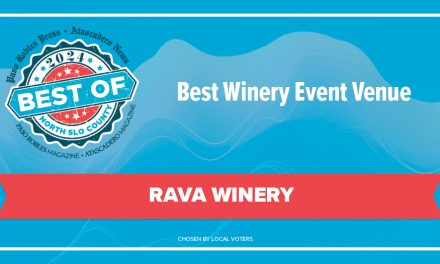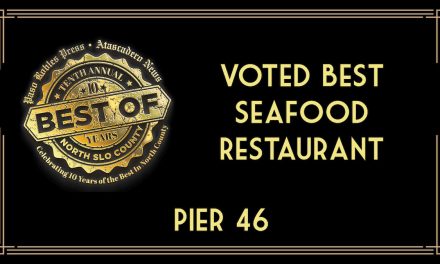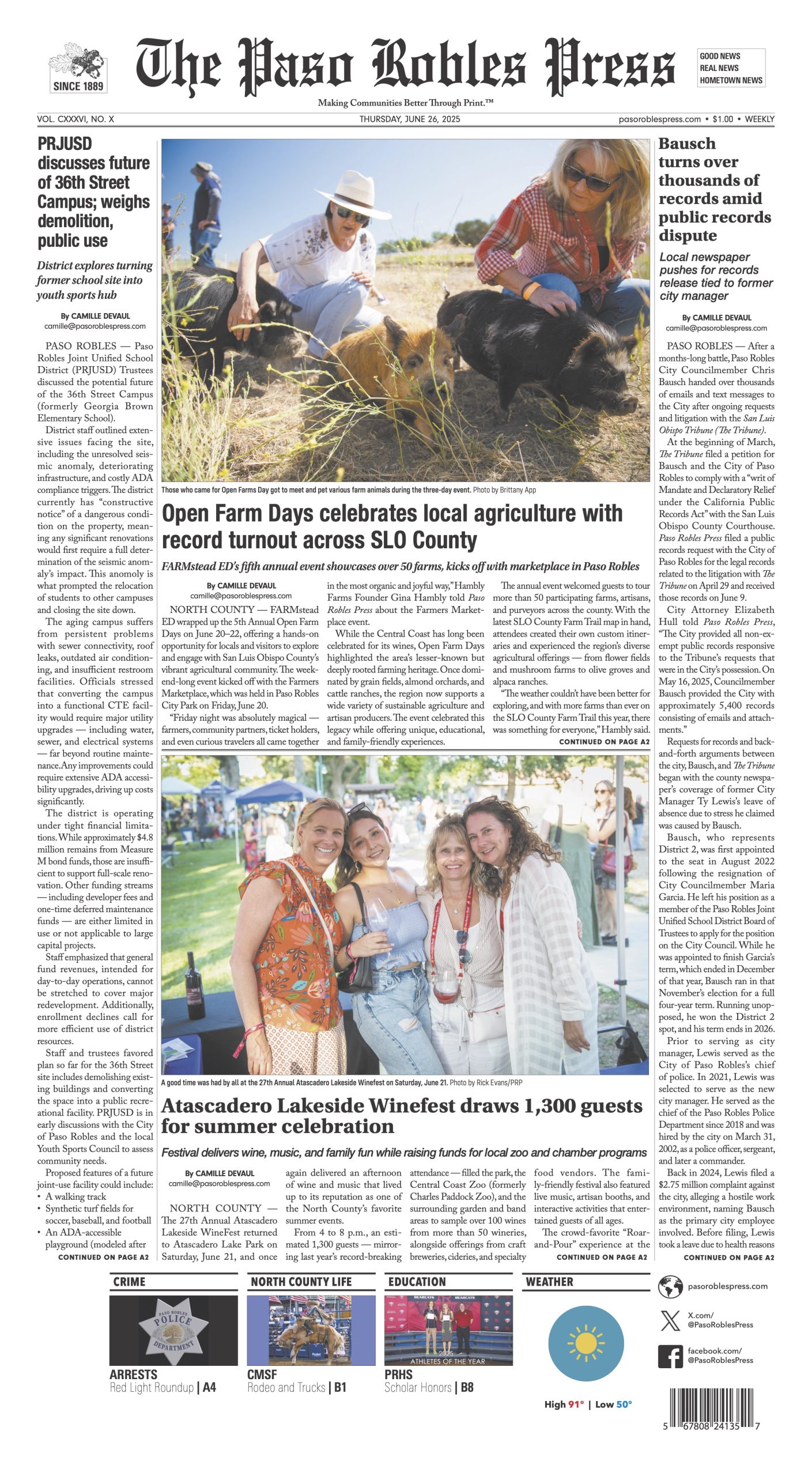
Merlot is gaining more than respect. It’s now trending with a steady following. As #MerlotMe marks its seventh anniversary this month, it’s clear this once-maligned varietal is back with a vengeance and here to stay. Merlot has found a firm footing on the wine menu not just with die-hard fans but a band of new-found merlot fanatics.

“When did merlot disappear?” This is a favorite comment by winemaker Goran Bjekovic. The owner of Aleksander by S&G Estate’s boutique winery in Paso Robles, Bjekovic has been a longtime fan of this varietal, so it’s no coincidence that when he acquired his ranch in Paso’s Creston area, it came with a 30-acre merlot vineyard. While he blends his merlot with some cabernet sauvignon and other Bordeaux varietals, several Paso winemakers are producing 100 percent merlot.
The #MerlotMe movement is the brainchild of Napa Valley’s Duckhorn family, known for its high-end luxury merlot. The family corralled the support of other dedicated Napa and Sonoma producers and thanks to their efforts several wineries from Washington State and our Central Coast have joined in this annual merlot promotion.

Last year the #MerlotMe campaign reached almost 20 million wine drinkers and generated more than 72 million impressions in over 40 states and 30 countries. In fact, in spite of all the merlot bashing, it’s the third leading red varietal purchased by Americans according to The Wine Institute.
As per USDA’s 2018 California Grape Acreage Report on merlot plantings, San Luis Obispo County accounts for 3,482 acres, San Joachin Valley 6,877 acres and Napa Valley 4,378 acres.
Some consider merlot as a blending wine and popularly it is bottled as such. But when it’s grown, picked and vinified with expertise, a varietal merlot can be opulent and decadent. It can burst with delicious red fruit flavors and soar with savory herbal notes.
So to celebrate merlot month I gathered a group of Paso winemakers and merlot fans at our home to sample a spectrum of merlots of vintages ranging from 2008-2017 from Napa Valley, Washington State and Paso wineries.

Several Paso producers craft unapologetically varietal merlot, people such as Rich Hartenberger of Midnight Cellars, Adam Lazzare of Lazarre wines and Neeta and Kunal Mittal founders of LXV Wine. “There’s a lot of good merlot in Paso, both east side and west,” noted Kunal.
On the varietal’s comeback, Lazarre commented: “Merlot is increasing at a clip. It’s pinot on steroids.” Lazarre sources his fruit from Paso’s choicest vineyards, crafting a small-lot production. We tasted two of Lazarre merlots — the 2010 aged for 26 months in 80 percent new French oak barrels was layered with plum and blackberry notes and the lively 2017 ringing with notes of dried herbs and hints of chocolate.
Other varietal merlots included the 2016 LXV Reserve from Cira Vineyard, exuberant with raspberry and red cherry notes and hints of dried herbs. Redolent with red fruits and laced with spice, the 2014 vintage from Ranchita Canyon Vineyard came from Paso’s east side.

One of Paso’s hidden secrets is Aleksander wine, a true reflection of Bordeaux’s Right Bank style. Bjekovic handcrafts two wines, a white and black label, with his European sensibilities and minimal intervention that allows the fruit to show its brilliance, bringing elegance and a lyrical balance to his wines. We sampled the 2011 white, a merlot-dominant blended with 20 percent cabernet sauvignon, aged for 18 months in French, Serbian and Eastern European barrels. This proved to be a well-structured seamless wine, rich and lush with hints of cloves and cedar.
We compared two merlots from Four Lanterns Vineyards & Winery.
The 2015 Lights Out, its fruit sourced from Doce Robles vineyard, expressed elegance and restraint much like Bordeaux’s Right Bank style. Conversely, the 2016 Sardius, a blend of 85 percent merlot and 15 percent cabernet sauvignon, was bold and audacious.

“The fruit for Sardius is sourced from Fratelli Perata vineyards and our home vineyard,” informed Jackie Gleason, co-owner of Four Lanterns. “It screams, ‘I’m American, notice me’.”
The velvety smooth 2016 Ecluse was exuberant with depth and concentration; Ancient Peaks’ 2017 spun a carousel of plum and blackberries with an undercurrent of mocha; Daou’s 2019 Micho, an equal blend of merlot and cabernet sauvignon was explosive with delicious plum flavor and traces of chocolate and mint. J. Lohr’s 2017 merlot blended with a splash of cabernet sauvignon and malbec was powerful with firm tannins and a lively acidity ringing with notes of black plum and violets.
Other merlot-driven blends ranged from the 2016 Robert Hall, a ruby-red hued wine lush with ripe black cherry notes; the 2017 Hearst Ranch Winery’s “Pico Creek” that was more chocolaty with an aroma of dark stone fruits; and San Simeon’s 2014 richly layered with black cherries and spices.

In the Napa Valley lineup, we savored Pahlmeyer, a wine that holds exalted status, a benchmark for many a merlot-lover. The 2016 was well structured with supple tannins and complex aromas of boysenberry and forest floor — a wine so plush it begs for cellaring.
From Napa’s mountainous regions, often identified as sweet spots for merlot, we sampled the 2016 Mt. Brave from Mt. Veeder region, exuberant with dark fruits, yet lyrical with hints of rose petal and spice. From Howell Mountain, the 2016 La Jota Vineyard’s merlot-driven wine, joined by a touch of tannat and petit verdot, rocked with ripe blackberry and dark chocolate and showed a satisfying weight on the palate.
The 2016 vintages from such pedigreed Napa names as Grgich Hills, Duckhorn, Charles Krug and Silverado Vineyard’s Estate Mt. George were all deliciously fruit-forward, elegantly structured and rounded by balanced tannins and acidity. Besides the current releases, we tasted a 2008 vintage from Napa’s Ahnfeldt Winery: the wine’s richness, complexity and Old World elegance was a testament to merlot’s age potential.
From Washington’s Walla Walla Valley, a 2016 L’Ecole No. 41 was expressive with aromatics and hints of spice. Bonterra’s 2017, a surprising blend of merlot with zinfandel and petite sirah, was expressive with licorice and dried herbs and produced from organic vineyards in Monterey and San Luis Obispo counties.
As #MerlotMe is still in swing, check out a range of merlots offered by Paso wineries among them Fratelli Perata, Pomar Junction, Castoro Cellars, Justin, Opolo, La Vigne, Dunning, Tobin James, Giornata, Sextant and Still Waters.











